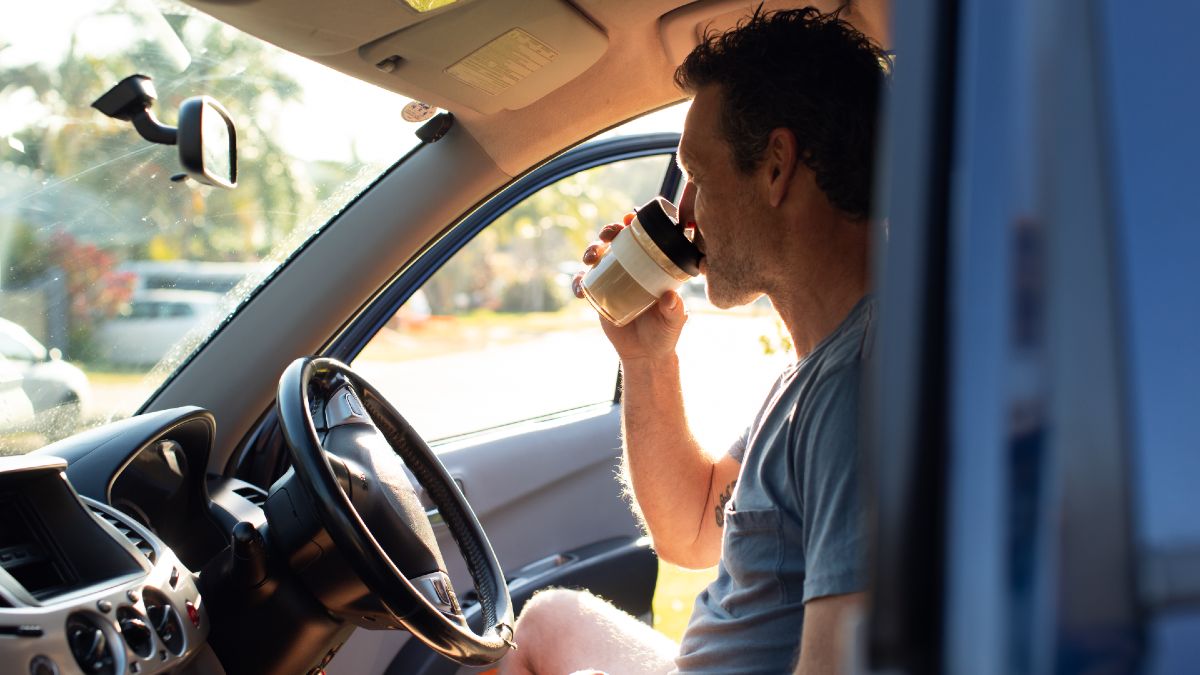Australians have fallen in love with air fryers. Discover how they work, their energy efficiency, what to avoid and which type is best for you.
A guide to the best reusable coffee cups

Avoid clogging up landfill with disposal coffee cups by switching to reusable coffee cups. Learn about the environmental benefits of reusable coffee cups, the pros and cons of different brands and materials, and which Melbourne cafes offer discounts for bringing your own mug.
According to Sustainability Victoria, Australians throw out 1 billion single-use or disposable coffee cups every year. That’s about 2.7 million cups every single day, while Planet Ark estimates that 60,000 tonnes of plastic waste end up in Australian landfill each year just from disposable coffee cups.
With the nation’s love of takeaway coffee showing no signs of abating, reusable coffee cups are often touted as the panacea to the disposable cup waste problem and reducing our carbon footprint.

Australians love takeaway coffee. Image: Getty
What are the environmental benefits of reusable coffee cups?
Clean Up Australia reports that disposable hot beverage cups are the second most common litter after plastic bottles. In fact, up to 90 per cent of single-use coffee cups end up in landfill – even if you pop them into the recycling bin – because standard disposable coffee cups have a plastic liner (usually polyethylene) to keep them waterproof. It’s too difficult for most paper recycling plants to remove the liner, so they go unused. Worst of all, it means that almost every load of recycling that has a coffee cup in it is contaminated and must be dumped.
Even compostable cups don’t help the problem. Australia also doesn’t yet have the facilities to effectively process compostable cups, so they are mostly sent straight to landfill instead.
The verdict? Single-use coffee cups are environmentally unfriendly.
“The alternative is to buy a reusable coffee cup that you can use time and time again,” says Elise Bennetts, Deputy CEO at STREAT, a social enterprise café and RACV corporate partner for the past seven years. STREAT runs five public cafes around Inner Melbourne, including at RACV Bourke Street.
What size reusable coffee cup do I need?
The size of reusable coffee cup you need depends on your usual coffee order. To save money and keep your drink hotter for longer, buy the smallest cup that fits your regular brew. Here is a coffee size guide to help you choose:
4 oz. (118 ml) – espresso, short macchiato, ristretto, piccolo
6 oz. (177 ml) – cortado, magic
8 oz. (237ml) – flat white, latte, cappuccino, mocha, filter, americano, long black, long macchiato
10-12 oz. (295-355 ml) – iced coffee, mocha, affogato, large sized coffees
14-16 oz. (414-473ml) – extra-large sized coffees.
A standard dine-in café cup is typically 160-200ml. An 8 oz. (237ml) cup will therefore comfortably fit most medium-sized coffees.

Make sure to get a reusable coffee cup that's the right size for your brew of choice. Image: Getty
What is the best reusable coffee cup material?
Stainless steel coffee cups
Stainless steel is arguably the best material for reusable coffee cups. A double-walled, vacuum-insulated stainless-steel cup is like a thermos: highly insulated to preserve your coffee’s heat without burning your hands. Stainless steel is also very durable, easy to clean and relatively lightweight. This is probably the greenest, cleanest reusable coffee cup material. Many even come with spill-proof lids. One downside is the slight metallic flavour that might affect your coffee’s taste over time – rinse your cup with some baking soda to fix this problem. Try quality brands like Hydro Flask, Fressko, KeepCup or Klean Kanteen for a stainless-steel coffee cup.
Ceramic coffee cups
Ceramic is a very popular reusable coffee cup material. Because it is an ‘inert’ material, it won’t retain odour or flavour, meaning that one quick rinse and you can enjoy a cup of tea or water without any coffee aftertaste. Ceramic also retains heat well, which is why the mugs in your cupboard are all made from this material. That said, ceramic is heavy to carry; it can also chip and stain over time. Frank Green is a great brand to try for a ceramic coffee cup.
Coffee waste husk coffee cups
“Husk coffee cups are amazing,” Elise said. “They are really durable, and they exist in a sustainable closed-loop system. They’re also a beautiful-looking cup.” These reusable coffee cups are sustainably made from the waste husk left over from coffee production. The Huskee brand even allows you to return worn-out cups to designated collection points, ensuring that they will be re-purposed into new products.
Bamboo coffee cups
Bamboo is a very eco-friendly reusable coffee cup material: it’s a renewable, fast-growing source and biodegrades once retired from use. It’s also naturally strong, durable, lightweight and antibacterial. Because they’re made from natural materials, however, bamboo coffee cups may not last as long as other materials and don’t retain heat.
Glass coffee cups
Glass looks stylish and doesn’t absorb any odours or flavours. “Coffee purists prefer glass coffee cups because the belief is that coffee tends to taste better in glass,” Elise says. “We did a big taste test with a range of different materials, and glass always won out.” On the other hand, glass can be heavy and prone to shattering if dropped. It is rarely insulated, so it doesn’t do well at preserving your drink’s heat. It can also burn your fingers when hot – although many glass cups come with a silicone band to solve this problem. If a glass reusable coffee cup is double-walled and therefore insulated, the glass needs to be made even thinner, which makes it more prone to breaking. Joco and KeepCup are quality reusable glass coffee cup brands to try.
Silicone coffee cups
Like its plastic variants, silicone coffee cups are lightweight, durable, transportable, and often antibacterial. It’s an excellent heat-resistant material, so it’s often used as the lid and/or heat grip on other reusable coffee cups. Silicone is also ‘inert’, so it won’t absorb odours or flavours. Unlike plastic, which is petroleum-based, silicone is created from silica (a product derived from sand) with some added chemicals. Some of these chemicals are derived from fossil fuels, however, and silicone takes up to 500 years to decompose once thrown away. That’s still much better than going through hundreds of single-use plastic/paper coffee cups, but there are more sustainable options. Crumple and HUNU are great collapsible, leak-proof silicone reusable coffee cups to try.
BPA-free plastic coffee cups
Reusable plastic coffee cups are super lightweight and often ‘crumple’ or fold down when empty for easy packing and transport. Most are also dishwasher-safe for easy cleaning. Just make sure to check that any plastic you drink from is BPA-free. Plastic does tend to absorb odour and flavour over time, so you will have to reserve the cup for coffee only. It’s also not a particularly environmentally friendly alternative to single-use coffee cups. Each time you wash your plastic coffee cup, you’re sending microplastics down the drain. Marine wildlife like plankton, fish, sea turtles and even whales mistake these tiny plastic pieces for food, which can be fatal. If they survive, those microplastics end up in us when we eat affected seafood. If you use plastic reusable coffee cups, stick to a reputable brand like KeepCup, rCUP or Frank Green.

Any type of reusable coffee cup is better than single-use cups. Image: Getty
What is a swap cup?
‘Swap cups’ are reusable coffee cups through programs like Green Caffeen that can be returned to any participating café after you’ve finished your hot beverage. The café cleans all returned cups to pour fresh drinks into the next time you visit. It’s like ordering a coffee in a mug at a table, but on the go. You can even have two cups on the go and drop in a dirty cup at the same time you make an order.
STREAT used to use rCUP at their Collingwood site, which is mainly visited by local residents who could easily return to the café. Unfortunately, COVID-19 forced coffee shops across Victoria to return to single-use coffee cups over 2020-21 to help stop the spread. “As soon as the pandemic hit, government health directives overtook environmental concerns,” Elise recounted. “It’s unfortunate, because we were on track to get rid of single-use cups in our cafés, but thankfully reusable coffee cups are now making a comeback.”
Do any Melbourne cafes offer discounts for reusable coffee cups?
Several Melbourne cafes used to knock off a few cents from your daily coffee if you bring your own reusable coffee cup – but this trend has dropped off in recent years.
“STREAT used to offer a 30-cent discount for using a reusable coffee cup, but then we thought – why reward behaviour that every person should be exhibiting?” explains Elise. “Instead, we put a 10-cent charge on requesting a single-use cup. We thought that would cause a lot of blowback. But the feedback we got was overwhelmingly positive. We’ve encouraged a lot of cafés to do the same thing. And it’s making a difference.”
STREAT also promotes Siptember: an initiative that encourages reusable coffee cup uptake throughout September. The program also allows STREAT to track how many customers are using reusable coffee cups as opposed to disposables. 33 per cent of STREAT customers used reusable coffee cups in 2019, up from 25 per cent in 2017 when the program began. These are especially impressive numbers compared to the national average of 3 to 7 per cent reusable coffee cup users. “In Siptember 2019, at our STREAT Café at RACV Bourke Street alone, we stopped 2,282 coffee cups from going to landfill,” says Elise. While the program was unable to run over the 2020-21 lockdowns, Siptember will be back in force this year.

Form the habit of bringing your reusable coffee cup with you each day to help reduce plastic waste. Image: Getty
What if I forget or lose my reusable coffee cup?
It’s not the end of the world if you forget or misplace your reusable coffee cup. “We interviewed a lot of customers at STREAT Collingwood and employees at RACV Bourke Street, asking people what the barriers were to bringing their own reusable coffee cups,” Elise says. “The biggest answer: ‘I forgot it’.”
You could take a cup from your kitchen cupboard at home, or even from your workplace (just make sure to return it). You could also relocate your meeting to a nearby coffee shop and sit down for a hot drink together, served in the café's mugs. Alternatively, ask your cafe whether they serve drinks in edible cups.
If you must use a disposable coffee cup, make sure to drop it off at a guaranteed disposable coffee cup recycling point at one of the 238 participating 7-Eleven stores across Victoria. Make sure to separate your lids – or better yet, refuse a lid when buying your coffee. You could even ask your workplace to get a Simply Cups collection tube to help your co-workers recycle their cups properly. So far, Simply Cups has diverted over 16 million coffee cups from landfill.
Elise has several recommendations to help you remember your reusable coffee cup. “You could start putting your reusable coffee cup next to the water bottle you always grab on your way out, or put a door hanger with ‘Don’t forget your cup’ on the inside of your front door.”


